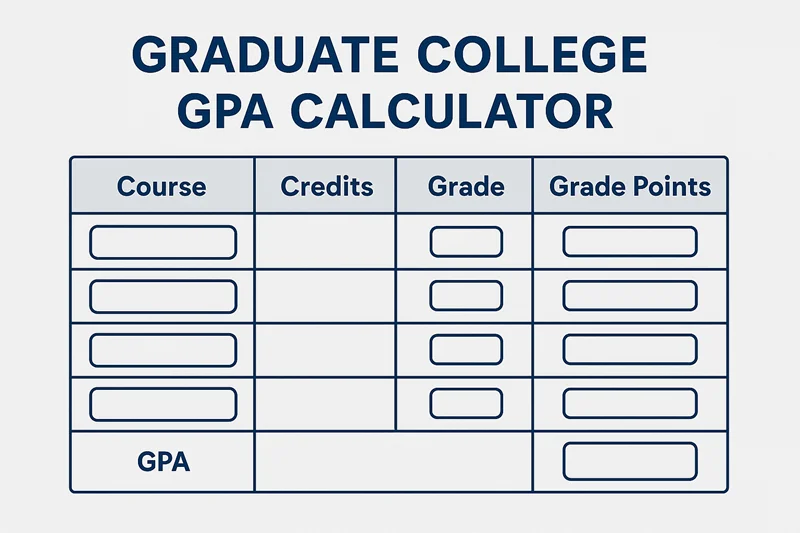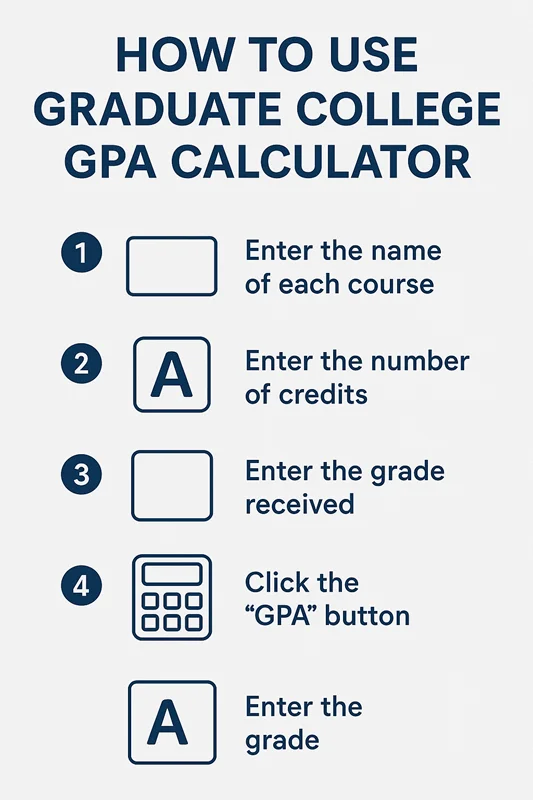Course Information
Grading Scale
Customize Grade Points
| Course Name | Grade | Credit Hours | Action |
|---|
GPA Results
Current Scale: Standard 4.0
A = 4.0, B = 3.0, C = 2.0, D = 1.0, F = 0.0
Calculate your cumulative GPA with precision and ease
| Course Name | Grade | Credit Hours | Action |
|---|
A = 4.0, B = 3.0, C = 2.0, D = 1.0, F = 0.0
Calculating your graduate GPA accurately is essential for maintaining academic standing, qualifying for scholarships, and meeting graduation requirements. Whether you’re pursuing a master’s degree, doctoral program, or professional certification, understanding how to calculate your grade point average helps you track your academic progress effectively.
This comprehensive guide provides everything you need to calculate your graduate GPA, including a detailed formula, step-by-step instructions, and practical examples that make the process clear and straightforward.
Our free graduate GPA calculator is specifically designed for graduate-level students and programs. The tool accommodates multiple courses with varying credit hours and provides instant, accurate results based on the standard 4.0 grading scale.
Key Features:
Simply input your course names, credit hours, and letter grades to receive your calculated GPA instantly. The tool automatically converts letter grades to grade points and performs all necessary calculations.
Graduate GPA represents your academic performance in graduate-level coursework, calculated using the same fundamental principles as undergraduate GPA but often with different standards and expectations.
Graduate programs typically maintain separate GPA calculations from undergraduate coursework. Your graduate GPA includes only courses taken during your graduate program and does not incorporate undergraduate grades.
Most graduate programs require higher GPA standards than undergraduate programs. While a 2.0 GPA might be acceptable for undergraduate graduation, graduate programs commonly require a minimum 3.0 GPA to remain in good standing.
Your graduate GPA directly impacts several important academic and professional opportunities:
Academic Standing: Most programs require a minimum 3.0 GPA to avoid academic probation and maintain enrollment eligibility.
Graduation Requirements: Many graduate programs set specific GPA thresholds that students must meet to graduate successfully.
Financial Aid: Scholarships, assistantships, and research positions often have GPA requirements ranging from 3.0 to 3.5 or higher.
Career Opportunities: Some employers, particularly in academia and research, consider graduate GPA when evaluating candidates.
Calculating your graduate GPA involves five straightforward steps that ensure accuracy and clarity in your academic record tracking.
Create a comprehensive list of all graduate courses you’ve completed or are currently taking. Include only courses that count toward your graduate degree program.
Exclude any undergraduate courses, continuing education credits, or non-degree coursework unless specifically included in your program requirements.
For each course, record the number of credit hours and the letter grade you received. Credit hours typically range from 1 to 4 credits for most graduate courses.
Ensure you use the exact credit hour values listed on your transcript, as these may vary between institutions and course types.
Transform each letter grade into its corresponding grade point value using the standard 4.0 scale:
For each course, multiply the grade points by the number of credit hours. This calculation determines the quality points earned for each course.
For example: A course with an “A” grade (4.0 points) worth 3 credit hours equals 12.0 quality points (4.0 × 3 = 12.0).
Add all quality points together and divide by the total number of credit hours attempted. This final calculation provides your cumulative graduate GPA.
Formula: GPA = Total Quality Points ÷ Total Credit Hours

The graduate GPA formula follows the standard weighted average calculation that accounts for varying credit hours across different courses.
GPA = Σ(Grade Points × Credit Hours) ÷ Σ(Credit Hours)
Example Calculation:
Course | Credit Hours | Letter Grade | Grade Points | Quality Points |
Research Methods | 3 | A | 4.0 | 12.0 |
Advanced Statistics | 3 | B+ | 3.3 | 9.9 |
Thesis Seminar | 2 | A- | 3.7 | 7.4 |
Ethics in Research | 3 | B | 3.0 | 9.0 |
Independent Study | 1 | A | 4.0 | 4.0 |
Calculation:
This student’s graduate GPA is 3.53, which demonstrates strong academic performance in their graduate program.
Use this comprehensive conversion table to accurately transform letter grades into grade points for your GPA calculation.
Letter Grade | Grade Points | Percentage Range | Description |
A | 4.0 | 93-100% | Excellent |
A- | 3.7 | 90-92% | Excellent |
B+ | 3.3 | 87-89% | Good |
B | 3.0 | 83-86% | Good |
B- | 2.7 | 80-82% | Good |
C+ | 2.3 | 77-79% | Satisfactory |
C | 2.0 | 73-76% | Satisfactory |
C- | 1.7 | 70-72% | Satisfactory |
D+ | 1.3 | 67-69% | Poor |
D | 1.0 | 63-66% | Poor |
D- | 0.7 | 60-62% | Poor |
F | 0.0 | Below 60% | Failing |
Note that some institutions may use slightly different grade point values or percentage ranges. Always consult your specific program’s grading policies for the most accurate conversion information.
Graduate programs maintain specific GPA standards that students must meet throughout their academic journey, with requirements varying by institution and program type.
Most graduate programs require a minimum cumulative GPA of 3.0 (B average) to graduate successfully. Some competitive programs or specialized fields may require higher thresholds:
Master’s Programs: Typically require 3.0 minimum GPA, with some programs requiring 3.25 or higher.
Doctoral Programs: Often require 3.0 to 3.3 minimum GPA, with additional requirements for comprehensive exams and dissertation defense.
Professional Programs: May have varying requirements, with programs like MBA or medical degrees sometimes requiring 3.2 or higher.
Graduate funding opportunities often have more stringent GPA requirements than basic program admission:
Teaching Assistantships: Commonly require 3.0 to 3.5 GPA minimum, depending on the institution and department.
Research Assistantships: May require 3.3 to 3.7 GPA, particularly for competitive research positions.
Merit Scholarships: Often require 3.5 to 3.8 GPA or higher, with some prestigious awards requiring near-perfect academic records.
Graduate programs monitor student academic standing through specific GPA thresholds:
Good Standing: Typically requires maintaining 3.0 GPA or higher throughout the program.
Academic Probation: Students with GPA below 3.0 may be placed on probation and given one semester to improve.
Academic Dismissal: Continued poor performance (usually below 2.5 GPA) may result in dismissal from the program.

A good graduate GPA is generally considered 3.5 or higher, while 3.0-3.4 represents satisfactory performance. Since graduate programs have higher academic standards, a 3.5+ GPA demonstrates strong academic achievement and opens doors to competitive opportunities like research positions, scholarships, and doctoral program admission.
Pass/fail courses typically do not factor into GPA calculations since they don't receive letter grades. However, "pass" grades usually require performance equivalent to a C or better. Some institutions may count "pass" as credit earned toward degree requirements without affecting the GPA, while "fail" grades might impact academic standing. Check your specific program's policies regarding pass/fail course treatment.
Yes, undergraduate GPA calculators use the same mathematical formula as graduate GPA calculations. The key difference lies in which courses you include—graduate GPA only considers graduate-level coursework. However, be aware that some graduate programs may have different grading scales or policies, so verify your institution's specific requirements before relying on any calculator.
Calculate your GPA at the end of each semester to track your academic progress and ensure you're meeting program requirements. Many students also calculate projected GPAs mid-semester to identify courses needing additional focus. Regular monitoring helps you stay aware of your academic standing and make informed decisions about course loads and study strategies.
Most graduate programs treat all courses equally in GPA calculations, regardless of difficulty or importance. However, some programs may have core course requirements or thesis credits that must meet specific grade thresholds even if they don't affect overall GPA weighting. Comprehensive exams, thesis defenses, and capstone projects may have separate evaluation criteria beyond traditional GPA calculation.
Enhance your academic planning and tracking with these additional calculators and resources:
Semester GPA Calculator: Calculate your GPA for individual semesters to track short-term academic performance and identify trends in your coursework.
Cumulative GPA Calculator: Combine multiple semesters or academic years to determine your overall graduate program GPA across your entire degree timeline.
Grade Calculator: Determine what grades you need on remaining assignments or exams to achieve target course grades and maintain your desired GPA.
Credit Hour Calculator: Plan your course load and graduation timeline by calculating total credits completed and remaining degree requirements.
Academic Calendar Planner: Organize important dates, deadlines, and milestones throughout your graduate program to stay on track for timely completion.
Tracking your graduate GPA accurately is crucial for academic success, funding opportunities, and career advancement. By understanding the calculation process and using reliable tools, you can monitor your progress and make informed decisions about your academic journey.
Regular GPA calculation helps you identify areas for improvement, maintain program requirements, and maximize opportunities for scholarships and research positions. Whether you’re just starting your graduate program or approaching graduation, staying informed about your academic performance empowers you to achieve your educational goals.
Bookmark this guide and calculator for easy access throughout your graduate studies. Take advantage of the step-by-step instructions, conversion tables, and examples to ensure accurate GPA tracking that supports your academic and professional success.